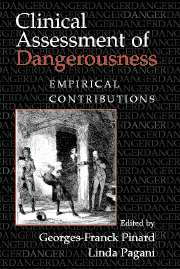Book contents
- Frontmatter
- Contents
- Contributors
- Prologue
- Introduction
- Basic Issues in Violence Research
- Mental Health Issues and Dangerousness
- Family Issues and Dangerousness
- 8 Risk Assessment for Intimate Partner Homicide
- 9 Parents at Risk of Filicide
- 10 Parricide
- Individual Characteristics and Dangerousness
- Conclusion
- Index
9 - Parents at Risk of Filicide
Published online by Cambridge University Press: 03 July 2009
- Frontmatter
- Contents
- Contributors
- Prologue
- Introduction
- Basic Issues in Violence Research
- Mental Health Issues and Dangerousness
- Family Issues and Dangerousness
- 8 Risk Assessment for Intimate Partner Homicide
- 9 Parents at Risk of Filicide
- 10 Parricide
- Individual Characteristics and Dangerousness
- Conclusion
- Index
Summary
Introduction
Homicide is a major contributor to child mortality. Moreover, official records of rates of child homicide are almost certainly underestimates. Some infant homicides are never discovered, especially those killed soon after delivery, and others are never recorded as such. For example, it is generally considered that at least 2% to 10% of registered cot deaths are probably homicides (Knowledon, Keeling, & Nicholl, 1985; Emery, 1985) and a more recent study suggests the proportion may be even greater (Wolkind, Taylor, Waite, Dalton, & Emery, 1993).
When a child becomes the victim of homicide, a parent is usually the perpetrator. In this chapter I will summarize what is known about the characteristics of children who have been killed and of the parents who killed them and what this may tell us about the underlying causes of such tragedies.
One of the major problems in understanding parental filicide is that most of the research into the subject has been obtained from either official statistics or from highly selective case samples; for example, parents referred to psychiatric or forensic services, or from anecdotal literature reports. The recording of official statistics tends to be unreliable and the range of data recorded limited, and because different countries tend to record information in different ways international comparisons are difficult. There are also cultural differences in the extent to which child homicides in themselves are consistently recorded.
- Type
- Chapter
- Information
- Clinical Assessment of DangerousnessEmpirical Contributions, pp. 158 - 180Publisher: Cambridge University PressPrint publication year: 2000
- 3
- Cited by



